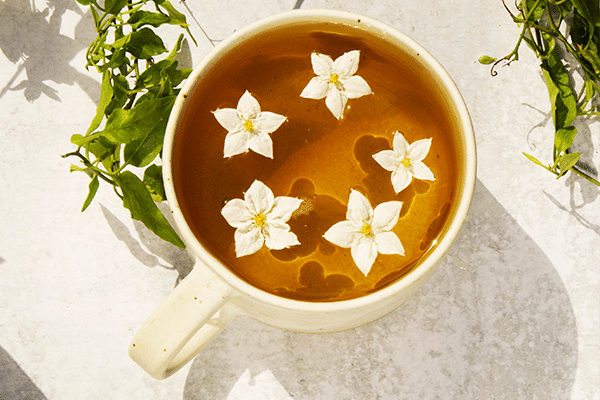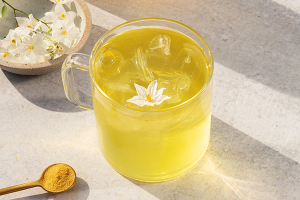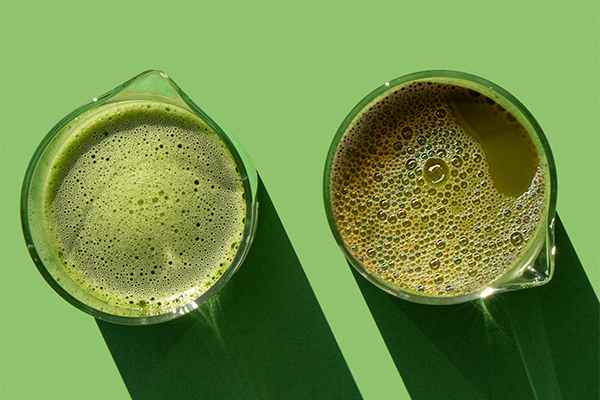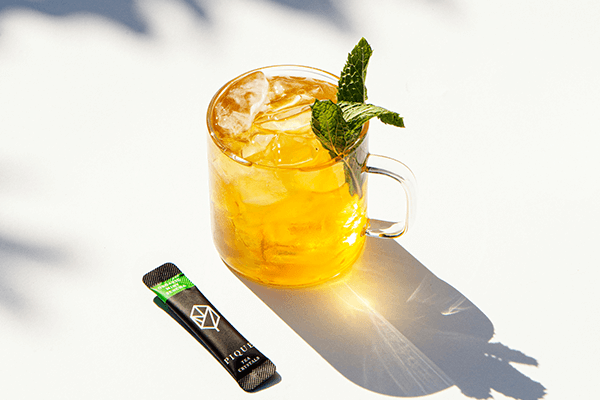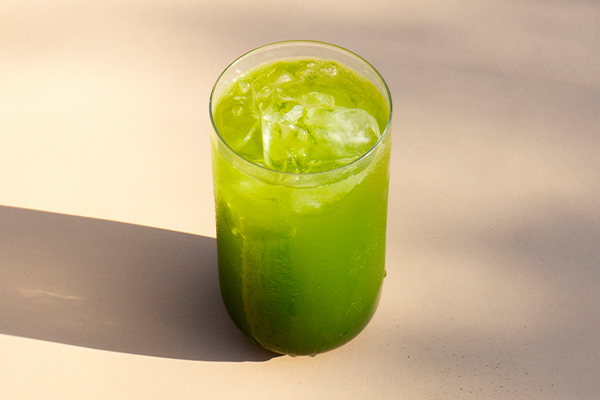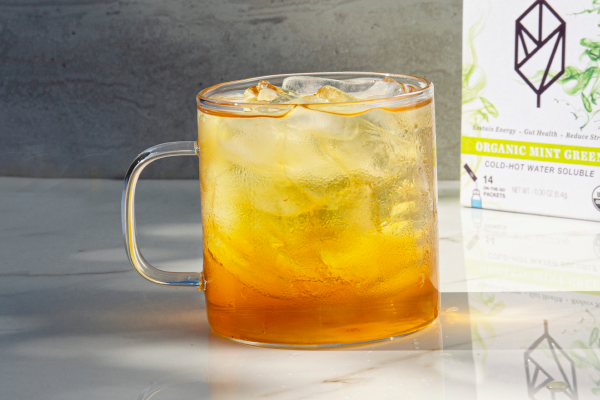If you’ve never experienced this fragrant, energizing tea, it might be time to give it a try. There’s a reason why Jasmine has been used to scent tea since the 5th Century (!) and remains a passionate favorite to this day.
Jasmine tea is a “true tea” that is unlike any other.
We’ve got all the details about its history, health benefits, uses in traditional herbalism – plus expert tips for making the perfect cup.
What is Jasmine Tea?
Jasmine tea is a scented tea made by combining leaves from the Camellia sinensis plant with flower petals from either Common Jasmine or Arabian Jasmine.
Some tea historians think the practice of using jasmine petals to flavor tea originated in the fifth century. That’s when jasmine flowers first came to China by way of India.
But the tea reached prominence in Fujian province during China’s Ming Dynasty, which began in 1368 and lasted for 276 years.
While jasmine tea remained popular in China for centuries, it didn’t reach the West through export or trade until the late 19th century.
Today, it’s among the most prevalent flavored teas worldwide.
What does Jasmine Tea taste like?
As with other true teas, the appearance and flavor of jasmine tea vary considerably. Both depend on the quality of tea leaves as well as their origin, processing, and preparation.
You can buy jasmine tea in typical loose-leaf form or as “jasmine pearls.” And some tea crafters include jasmine petals in the finished product, while others do not.
However, variations aside, most jasmine tea shares a delicate, sweet, floral taste with a bright, fresh finish and a perfumed aroma – the same distinctive aroma found in jasmine flowers.
What Are Jasmine Flowers?
Teamakers use two species for jasmine tea: Common Jasmine (Jasminum officinale) and Arabian Jasmine (Jasminum sambac), also called Sampaguita.
Both species belong to the olive family, Oleacaea and produce white flowers with an intense scent. They grow only in temperate or tropical regions.
But while Common Jasmine only blooms in summer, Arabian Jasmine blooms year-round.
There are also differences when it comes to the aroma and flavor profile of each flower. Jasminum officinale has a warm, rich, sweet scent, whereas Jasminum sambac is mellower and less sweet, with citrus, honey, and herbaceous notes.
Is Jasmine Tea Green or Black?
Either! Or both!
While green tea leaves are the most common “base” tea for jasmine tea, some teamakers use white tea, black tea, and even oolong teag or pu’er teas. And as you would expect, the processing of Camellia sinensis leaves beforehand also affects the properties and health benefits of jasmine tea.
Here’s your recommendation for a Jasmine Green Tea:
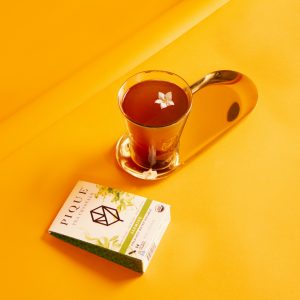
Pique Jasmine Green Tea
Catechins in full bloom. Clean energy + gut support. Exotic fragrance to transport the senses.
How is Jasmine Tea Made?
As with other types of tea, the manufacturing process of jasmine tea varies according to the tea grade and location where it’s produced.
Generally speaking, jasmine tea producers harvest tea leaves in spring, then save them until the summer when jasmine flowers bloom. In between, the tea leaves oxidize, resulting in a more complex flavor profile and other chemical changes.
Compared to most teas, the tea-making process for jasmine tea is more labor-intensive because it requires harvesting thousands of tiny, delicate jasmine blossoms for the scenting process.
It also relies on precise timing. The highest-grade jasmine teas use jasmine flowers plucked at night because the aroma of jasmine is strongest at that time.
What happens next is known as scenting. While makers of low grade tea may simply mix jasmine buds in with green tea prior to packaging, the authentic process is not so simple.
Crafters layer fresh jasmine petals onto tea leaves and then leave them, infusing them with the unique scent and flavor of jasmine.
Often, the scenting is repeated more than once. Many teamakers throw away the old petals and replace them with fresh ones to amplify the essence of jasmine.
The most exquisite jasmine teas, such as Yin Hao and Dragon Pearls, go through the layering process seven to nine times.
What is Jasmine Tea Good For? 5 Health Benefits of Jasmine Tea
1. Supports Calm Focus
As you may already know, Camellia sinensis teas are both stimulating and relaxing at once. These properties occur thanks to tea’s relatively low caffeine content, paired with the natural amino acid l-theanine.
Studies show that l-theanine promotes alpha brain waves, which are associated with a state of “alert relaxation” (1).
In other words, compared to coffee, drinking tea gives you jitter-free focus. It picks you up, then sets you down gently with no crash.
L-theanine also helps support a healthier response to stress, which is perfect for busy days (2).
Because of its tea leaf base, jasmine tea is full of l-theanine, with just the right caffeine level.
Bonus: some research suggests that jasmine tea “one-ups” the stress-busting benefits of most true teas (3).
See, the addition of jasmine petals makes this tea high in linalool, one of the components responsible for the floral aroma you smell when brewing or drinking jasmine tea.
The smell of linalool isn’t merely pleasant – science says it may even help you chill out (3)(4). So remember to inhale deeply as you sip, especially if you’re having a rough day!
2. Supports Healthy Skin
Healthy skin is beautiful skin, and jasmine tea may promote skin health in a few different ways.
For one thing, the polyphenols found in tea can help support healthy aging by acting as antioxidants, keeping you looking good from the inside out (5).
But jasmine petals themselves also pack a punch when it comes to skin health.
Studies show that some components of jasmine flowers may have cleansing properties while also supporting your skin’s natural ability to heal (6)(7).
Most research focuses on the topical effects of jasmine for skin health, implying concentrated jasmine tea might be the perfect addition to homemade skincare products.
Whether you drink it, use it in scrubs and rinses, or both, your skin will appreciate the benefits of jasmine tea.
3. Supports Healthy Cells
Green tea, the most common base for jasmine tea, is high in antioxidant polyphenols and catechins like EGCG that support cellular health (8).
But along with the usual amazing health-promoting compounds found in tea, jasmine tea has extra free radical scavengers thanks to jasmine petals (9)(10).
That means jasmine tea is a fantastic choice if you want even more antioxidants than most true teas.
4. Supports Healthy Cholesterol Levels
As many as 17 separate clinical trials show that green tea may help support healthy cholesterol levels in humans (11).
And an animal study found that compared to other types of teas, Chinese green tea and jasmine tea had the most benefit for cholesterol levels (12).
While it isn’t proven yet, there’s a chance that unique jasmine antioxidants may boost the ability of jasmine tea to promote healthy cholesterol levels even further.
5. Supports Gut Health
Drinking tea supports a healthy gut because some polyphenols act as prebiotics, nourishing your microbiome by feeding your gut bacteria (13).
And in the case of fermented teas like pu’er, we can add a probiotic (providing healthy bacteria) benefit to the list, too (14).
Also, drinking tea helps support your body’s natural anti-inflammatory response throughout your body, including in your gut (15).
While it’s too early to say for sure, some animal evidence suggests that jasmine may help support your body’s ability to maintain a healthy gut by promoting high levels of natural cellular antioxidants (16).
Jasmine Tea and Traditional Chinese Medicine
If you aren’t familiar with TCM, it classifies foods into either a “cooling” or “warming” category.
Unlike typical white and green teas, teas made with jasmine are warming.
Whereas cooling teas are good for summer heat, clearing excess dampness, and aiding digestion of heavy foods, warming teas like jasmine are ideal for cold-naturedness, weak digestion, or bloating.
Another way of describing jasmine tea is that it tonifies or increases yang.
In TCM, balancing or regulating qi or life-force is essential for health and wellness. An imbalance in qi is expressed in terms of yin (cool, damp, dark) and yang (warm, dry, bright).
People with low yang may include vegetarians, vegans, people who live in cold climates, have lethargy or low energy, or who work too much. Jasmine tea might be a perfect fit if you fall into any of those categories.
How to Enjoy Jasmine Tea
To brew a perfect cup of jasmine tea, you’ll want to begin by steering clear of low-grade teas.
First of all, avoid bagged tea. For one thing, bagged grocery store teas are usually low-quality.
But even when bagged teas are of acceptable quality, the tiny tea bags don’t allow leaves to expand properly during steeping. And the bags may contain chlorine, plastics, and other undesirable chemicals.
Long story short: stick with loose leaf tea or high-quality tea crystals. Here’s our recommendation for a high-quality jasmine tea:

Pique Jasmine Green Tea
Catechins in full bloom. Clean energy + gut support. Exotic fragrance to transport the senses.
Also, inspect before you select. Believe it or not, the inclusion of too many jasmine petals is a red flag.
Lots of petals may indicate that the manufacturer just threw petals in with green tea rather than using the traditional layering method.
On the other hand, if there are no petals, there’s a possibility that the tea was made using “natural jasmine flavor” rather than fresh jasmine flowers.
In the end, your best bet is to stick with a reputable brand or supplier.
Brewing Jasmine Tea
Brewing jasmine tea is easy. But for best results, you’ll need to know what type of leaves you’re working with.
Jasmine green tea, the most common type, brews best between 170-180 degrees Fahrenheit (76.5 to 82° Celsius). If you aren’t certain what type of jasmine tea you have, it’s most likely green jasmine.
In contrast, white jasmine develops the best flavors around 160-170 degrees Fahrenheit (71-76.5° Celsius), while the sweet spot for black jasmine is 190-212 degrees Fahrenheit (88-100° Celsius).
Steep your tea 3-5 minutes. You can try longer durations, but be aware that even if you usually prefer stronger tea, jasmine’s floral notes can quickly overpower the subtler tea taste if you steep too long.
Final Thoughts
Jasmine tea offers all the benefits of green tea and other true teas and herbal tea, plus more. Think of it as tea with added aromatherapy benefits, not to mention a fantastic and fun skincare ingredient.
With its delicate flavor, it makes a delightful iced tea as well.
However, if you haven’t experienced jasmine tea yet, it’s worth a try – you just might discover your new favorite.
